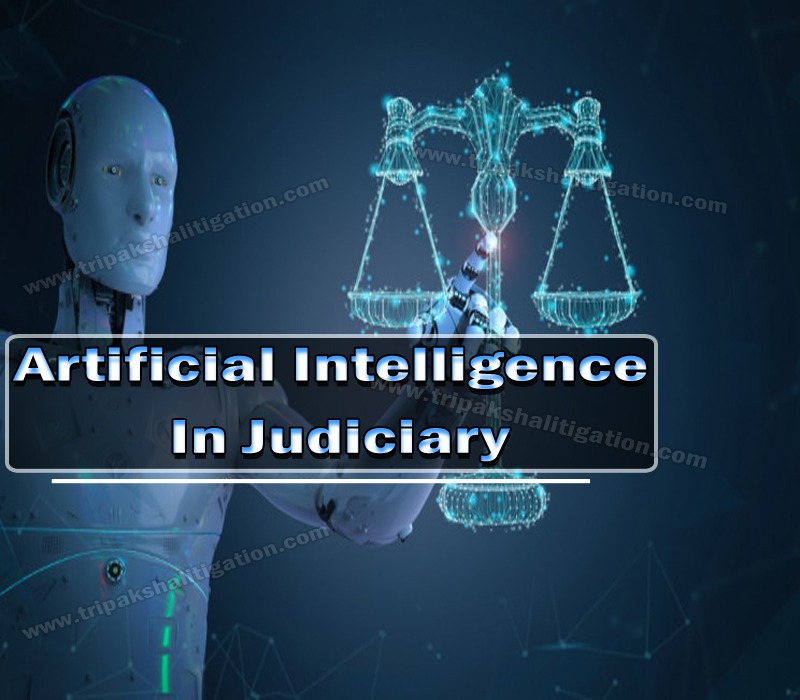“Success in creating Artificial Intelligence would be the biggest event in human history” –Stephen Hawkings
“In the long term, artificial intelligence and automation are going to be taking over so much of what gives human a feeling of purpose” –Matt Bellamy
Artificial intelligence does not need a preface; it’s a word which every tech person is aware of. In the 21st century every child and each individual is familiar with the gadgets and new technologies since the childhood so, it is not difficult for them to understand the idea of artificial intelligence.
As many are in favor of this development and root for artificial intelligence to take over this world thus, some are still against it.
In our article we are going to discuss the role of artificial intelligence in our judicial system and how it can enhance and speed up the work of judicial system.
But let’s try and understand the concept of artificial intelligence
ARTIFICIAL INTELLIGNCE (AI):
As per general public who doesn’t have the technical background they understand AI as a technology to automate tasks that normally require human intelligence and reducing workload of humans.
This description of AI emphasizes that the technology is often focused upon automating specific types of tasks, those that are thought to involve intelligence when people perform them. A few examples can help illustrate this depiction of AI. Researchers have successfully applied AI technology to automate some complex activities, including playing chess, translating languages, and driving vehicles. When an individual perform these activities, they use various higher-order cognitive processes associated with human intelligence.
In short, when engineers automate an activity that requires cognitive activity when performed by humans, it is common to describe this as an application of AI. This definition, though not fully descriptive of all AI activities, is nonetheless helpful as a working depiction.
Putting in simples form artificial intelligence is the ability of a computer program to think and learn from the data it comes across, they are smart and work on their own without being encoded with commands. This is how AI will appear in future once it is used in collaboration with humans.
But in reality of now AI systems are decidedly not intelligent thinking machines in any meaningful sense. AI systems are often able to produce useful, intelligent results without intelligence. These systems do this largely through heuristics i.e. by detecting patterns in data and using knowledge, rules, and information that have been specifically encoded by people into forms that can be processed by computers.
JUDICIAL OFFICERS SIGHT ON AI:
As we have entered in the world of technology where we are using smart phones, smart watches, automatic cars, video conferencing with person living in another state or country, this shows that we are mostly relied on technology to do our major works.
The use of AI can be seen in the navigation system used by major population, large industries, start-up overview, banks and in our judiciary system.
This further brings out a topic of discussion on using technology i.e. AI in judiciary.
In recent, 79th Foundation Day celebration of the Income Tax Appellate Tribunal, the Chief Justice of India i.e. SA Bobde has proposed to introduce AI that would help in better administration in of justice delivery. He further said the use of technology in judicial functioning is a fascinating area and a significant breakthrough.
“Though I must make one thing clear: Because we have been dealing with the introduction of artificial intelligence in courts, I am firmly of the view, based on the experience of systems that have used artificial intelligence, that it is only the repetitive area or decision making such as rates of taxation, etc., or something that is invariably the same or which is in a sense mechanical, and that must be covered by artificial intelligence.”
He further stated “the artificial intelligence system we are looking to employ in courts possesses the reading speeds of 1 million characters per second. I can imagine a similar system can be used to read and extract all relevant facts, compute tax effect and assist in a myriad of ways to propel the pace of decision making”.
AI can play a significant role in tribunals, like ITAT (Income tax appellate tribunal) in docket management and decision making, it can do the same in other judicial institutions.
Where Chief Justice of India has faith in AI and believes that it can do many great things to improve the judiciary course of action, also he resolutely believes that though AI can work independently and enhance the working speed of judges but it cannot replace humans specifically, the knowledge and wisdom of judges. The deployment of the AI system will help reduce pendency and expedite judicial adjunction.
On the other hand some other doesn’t share the same confidence, many other judicial officers have concern that automated AI’s enhanced decisions may disproportionately appear to be more neutral, objective, and accurate than they actually are. Further, judicial officers may inappropriately defer to this false precision, failing to take into account the limits of the model, the uncertainties involved, the subjective decisions that went into the model’s creation, and the fact that even if the model is accurate, still two times out of ten such a criminal defendant is not likely to reoffend.
UTILIZATIONOF AI IN JUDICIARY:
In the context of Indian Judicial system we are already au fait in regard to the judiciary is overburdened with the cases. At present if we talk about Supreme Court 58,519 cases are pending and further if we talk about district courts in India will lose counts.
Numerous of cases are fairly analogous in nature are being filed each year. There are very few efforts made to analyze how these cases are progressing at every stage. Judges need to be equipped with enough information about the possible paths that the case could take to help in faster disposal of the case. Artificial Intelligence (AI) is the new technology which is capable of assisting judges by predicting vital information regarding an ongoing case based on past cases of an analogous nature.
The vital information regarding the ongoing cases are generally the case details which constitutes number of accused in a case, date of filing of the charge sheet, number of witnesses examined during evidence stage, witness turning hostile, reasons for adjournments, First Information Report (FIR) details, quantum of punishment, compensation granted etc. which are recorded in the daily orders and the final judgment can be used for this analysis. Analysis of these variables can help judges make better strategic decisions which can help reducing delays in a case.
Similarly, where a large volume of documentary and oral evidence is brought on record the same in so far as possible may be kept in a machine readable format. A well trained AI algorithm would be a reliable tool in the hands of the trial judges in highlighting the summary of the documents and oral evidence. It would greatly enhance the capability of the trial judges in adjudicating complex matters involving voluminous records efficiently.
The same case can be seen in the legal contracts, the legal contracts that are expressed electronically and in which the meaning of the contract is expressed in computer-understandable form.
A good example of this comes from many securities contracts in the finance industry where the trading contracts are expressed in computer-understandable form that allows the computer to automatically carry out the underlying trading logic behind the contract.
A final example of the use of AI in law involves the “Do Not Pay” app, which provides a basic legal expert system that allows users to navigate the legal system it is a legal self-help systems. These are simple expert systems often in the form of chatbots that provide ordinary users with answers to basic legal questions.
These all are small steps taken towards the development and more efficacy of judicial system. Implementation of AI will give a divergent view to the judiciary; its assistance will help judges all over India in providing justice to litigants in more effective and transparent way.
With every pros there is cons as well, where many judicial officers are comfortable with experiencing new idea of AI in judiciary many other have their doubts.
AI is intelligent it works depends on various algorithms. It is machine which is incapable of understanding human emotions, where humans decide things with the help of tier brain and hearts; AI will be relying on data and algorithm, high end computer processors.
Despite the intelligence of such algorithms, there will be inaccuracies as is the case with all unstructured data sources. In order to build a robust algorithm, data needs to be structured. Unfortunately, most of the relevant data on the e-courts website (official website containing case related data from across India) is not in a structured format. Data which is in heavy text format e.g. order sheets & judgments needs to be recorded in a more structured manner.
Most importantly, when it come to human emotions we are not as clear as computer or in this case AI. It will see everything as black and white where judges have to consider the grey area as well. The other major concern is that AI is highly intelligent and can work independently so there is threat of it taking over judiciary by removing judges.
Another contemporary issue with AI and the law has to do with the interpretability of AI systems and transparency around how AI systems are making their decisions. Often AI systems are designed in such a way that the underlying mechanism is not interpretable even by the programmers who created them. Various critics have raised concerns that AI systems that engage in decision-making should be explainable, interpretable, or at least transparent.
CONCLUSION:
As it currently stands, AI is neither magic nor is it intelligent in the human-cognitive sense of the word. Rather, today’s AI technology is able to produce intelligent results without intelligence by harnessing patterns, rules, and heuristic proxies that allow it to make useful decisions in certain, narrow contexts.
The world has evolved and stepped into the digital world where now we make payments through our smart phone, simple online transactions, online using latest gadgets to make our work more effortless.
Similarly, judicial system has also evolved and started accepted the digitalized world, we have E-courts, and we have started online filing in numerous Tribunals. The E-portal is the significant step Judicial System has taken towards the modern and digital India. The use of AI will enhance the scope of judicial work and reduce the burden of the judges, most importantly it will speed up the adjudication of matters and delivering of justice which optimistically affect the pending cases in the courts.
In many foreign courts we can see the implementation of AI like France, Austria etc, these countries been in a beneficiary situation after the implementation of AI in their judiciary, like by Analysis of decision documents and extraction of metadata • Recognition of natural and legal persons, addresses and current role • Anonymisation of personal data of parties • Anonymisation while preserving the comprehensibility of the case.
A major issue arise during our discussion was that there will be inaccuracies due to unstructured data; Austria advanced AI technology for issues like this; for consistent file management, incoming unstructured documents should be processed uniformly and metadata should be adopted automatically. The intelligent digitization of existing paper files should also be supported.
We can also adapt some ideas from the other countries like Austria and advance the AI technology for more organized work.
However, current AI technology has its limitations. Notably, it is not very good at dealing with abstractions, understanding meaning, and transferring knowledge from one activity to another, and handling completely unstructured or open-ended tasks. Rather, most tasks where AI has proven successful (e.g., chess, credit card fraud, tumor detection) involve highly structured areas where there are clear right or wrong answers and strong underlying patterns that can be algorithmically detected.
Knowing the strengths and limits of current AI technology is crucial to the understanding of AI within law. It helps us have a realistic understanding of where AI is likely to impact the practice and administration of law and, just as importantly, where it is not.
When we have already initiated our step in trail of digital India we can achieve more from the implementation of AI in judiciary. India is the second largest populated country and in this population pending cases had crossed counting in crore all over the states. We are more in need of the advance AI technology. Humans mind can upto an extent bear the workload and stress, in this situation letting AI assist in reducing that workload and delivering efficient justice to the litigants will have constructive effect on judiciary and as well as our country.
You may contact me for consultation or advice by visiting Contact Us








